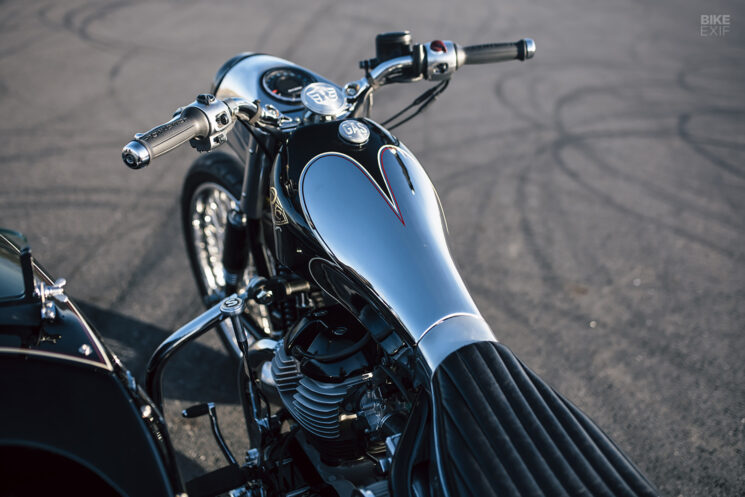
A flourishing custom scene works wonders for brand culture, and it’s in the manufacturers’ interest to get their newest models in the hands of talented builders to boost the buzz. Kaichiroh Kurosu of Tokyo-based Cherry’s Company has some astonishing classic Harleys and modern street machines to his credit, and Royal Enfield recently tapped him to work his magic on the new Super Meteor 650.
Royal Enfield specified only that the bike needed to retain its cruiser spirit, giving Kurosu-san the freedom to check off a bucket list build; a sidecar rig.

Given his shop’s diverse resume, it comes as no surprise that Kaichiroh wanted to tackle a sidecar build, but that’s a prompt that doesn’t come in every day. “A sidecar is also a great cruiser,” he reasoned, but executing it successfully entailed a whole lot more than adding a few cart provisions—leading Kaichiroh to nickname this project ‘Challenger.’
A sidecar rig requires a reduction in trail for easier steering, so Kaichiroh got to work on a major font end conversion inspired by Earles forks of the 1950s and 60s. The design was used by several major manufacturers for its rugged construction, and the ability to adjust the pivot position for a reduction in trail with a sidecar attached.

Since adapting an OE Earles fork to the 650 Meteor would be clumsy at best, Kaichiroh built his own, matching its construction to the bike’s compact chassis and incorporating an eccentric adjuster to simplify altering trail geometry. KONI shocks were chosen for dampening, and Kaichiroh hand-picked coils that supplied the right spring rate without being too bulky for the handmade front end.
For the rest of the chassis, Kaichiroh had a low, sloping design in mind, as used in his ‘Lefty Bond’ Shovelhead, which would call for a scratch-built frame. But upon stripping the Meteor down to bare bones and dropping the ride height, he found the majority of the stock frame was up to the task with the right adjustments.

The stock neck was reworked, trading the bulky factory gusset plate for a cleaner truss-style reinforcement. Kaichiroh also took the opportunity to offset the engine to the left by reworking the backbone and rear suspension pivot point, which would accommodate a wider rear wheel. The adjustments seem subtle, but the transformation is remarkable considering how much of the stock equipment was preserved.

Flowing alloy bodywork further sets Challenger apart from its stock roots, with each handmade piece blending seamlessly into the next. The fuel tank is a one-off made from steel, while the seat pan and headlight nacelle were executed in aluminum.
The headlight lens looks like something scrounged from a 39 Ford Coupe or 40 Willys, but it’s actually a one-off resin piece. A tasteful array of scallops, pinstriping and gold leaf provides the finishing touch to the show-polished tins.

While the Meteor 650 had good usable bones, Challenger’s sidecar was a complete scratch-built affair to match the motorcycle’s style and middleweight stature. Kaichiroh melded vintage sidecar designs with influence from the Klomp (the traditional wooden clog from the Netherlands) to come up with the shape, and hand-formed a styrofoam plug before laying it up in fiberglass.
Unwilling to forego functionality, the sidecar body is big enough to fit an adult and rides comfortably on its own frame and suspension. Its 19-inch, 60-spoke wheel rides on a leaf spring from a K-truck, dampened by a standard motorcycle shock, and Kaichiroh built in the ability to adjust toe and camber angle as well.

Inquiring minds will question the lack of a disc on the 21-inch, 60-spoke front wheel, especially when carrying a passenger, but Kurosu has a novel solution for that as well. The sidecar has its own disc brake, a W&W 8.75-inch rotor with a Performance Machine caliper, and Challenger’s rear wheel has discs on both sides.
The bike’s foot brake lever controls the sidecar caliper and the brake hidden behind the sprocket, while the right lever controls the disc brake on the right. Kurosu also worked in a mechanical parking brake on the right disc, a functional consideration many would have overlooked.

Kaichiroh Kurosu’s Challenger is a feel-good machine with a totally unique mix of one-off style and practicality. It has stage presence without forgoing functionality, and most of the Meteor’s stock systems were left well enough alone. If I’m Royal Enfield, I’m considering that a home run.
Cherry’s Company | Facebook | Instagram | Images by Hiromitsu Yasui
